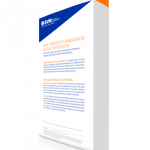The following was adapted from a lunch & learn presentation at Sperry Van Ness | RICORE Investment Management, Inc in Cincinnati, Ohio. This is part one in a four-part series.
Demystifying the Commercial Lease: Part One
A typical commercial lease is a comprehensive document that may be anywhere from 20 to 60 pages long. (Often with exhibits these things can be huge! So, reviewing new leases can be a real headache for an agent trying to sell or property manager taking on the management of a new multi-tenant property or shopping center.) When paging through a lease many provisions can seem irrelevant, extraneous, unimportant or rarely used. The fact is that every lease provision is drafted to address a specific event, need or situation that a landlord or tenant may face. Today, I was asked to address some of the more ‘legalistic’ provisions in the commercial lease in an attempt to try to ‘demystify’ them for you.
I. Subordination, Non-Disturbance and Attornment, and ‘SNDA Agreements.’
The first topic is Subordination, Non-Disturbance and Attornment. These are separate concepts and may appear, separately or together, in a commercial lease. There are also Subordination, Non-Disturbance and Attornment Agreements, commonly called ‘SNDA Agreements.’ However, it is important to understand that the three concepts do not always exist together.
A. Subordination.
1. Priority of Interests in Real Estate. Any discussion involving ‘subordination’ necessarily involves an understanding of how priorities of interests in real estate are determined. (I am speaking of such items as deeds, leases, mortgages, mechanics liens, and so on.)
a. For an interest in real property to receive priority it must be properly executed, acknowledged and recorded.
b. As a general rule, first in time is first in right unless there is an agreement to the contrary.
2. In Ohio, a sale of property at foreclosure results in termination of any lease that was made subsequent to, and is subordinate to, the mortgage. A lease that is prior in time to the mortgage remains undisturbed by the foreclosure.
3. A lender or mortgagee may voluntarily elect to subordinate the mortgage to subsequent leases. Similarly, a lease may provide that it will be subordinate to any future mortgages. In any event, it is the party with priority who must consent to making another interest superior to its own. Simply inserting a provision into a lease or a lending agreement that such interest will be superior to all other prior and subsequent interests will not force a party with priority into a junior position.
B. Attornment. Many lenders will require that any leases entered into by the owner/borrower contain a subordination provision in favor of the mortgagee/lender. This agreement is often coupled with an attornment agreement. An attornment agreement is an agreement in favor of the lender in which the tenant agrees to recognize the purchaser at foreclosure as his new landlord. Such an agreement overcomes the obstacle of automatic termination of subordinate leases upon foreclosure by providing that, in effect, the tenant will enter into a new lease with the purchaser on the same terms as the old lease. Therefore, the lender is assured that at least some rental income will continue after foreclosure (i.e. rental cash flow is maintained). The attornment agreement may also provide that the attornment be at the lender’s option. In such an instance, the lender would then have the right to terminate the lease or hold the tenant to its obligations.
Attorn: Means to agree to be tenant to a new owner or landlord of the same property. Merriam-Webster Dictionary online.
C. Non-Disturbance. A lender may also execute a non-disturbance agreement in favor of one or more tenants. Under such an agreement, usually entered into directly between the lender and the tenant, the lender agrees that in the event of foreclosure, the lender will not terminate the tenant’s lease or otherwise disturb the tenant’s rights so long as the tenant complies with the lease. Such an agreement protects the tenant against risk of foreclosure, and usually is coupled with subordination and attornment provisions for the lender’s benefit. Thus, regardless of priority, the lease survives foreclosure and the tenant attorns to the lender or purchaser at foreclosure. As a practical matter, where the lease is long-term or the tenant intends to make substantial improvements to the leased premises, it is advisable for the tenant, as part of its lease negotiations, to protect its investment against the risk of foreclosure by obtaining a non-disturbance agreement from any existing mortgagee and by refusing to subordinate its lease to any future mortgagee unless the future mortgagee enters into a non-disturbance agreement for the tenant’s benefit.
Note: A lender or landlord does not have to offer an SNDA Agreement. A lender may only offer a subordination and attornment (at the lender’s option) agreement, a SA Agreement (if you will), since this is most in the lender’s favor. A savvy or well-represented tenant will know to ask for a non-disturbance agreement as a ‘quid pro quo’ for a subordination and attornment agreement.
[bctt tweet=”SDNA Agreements in a #CRE Lease: Don’t disregard it b/c you don’t understand it. Learn about it here:”]
D. SNDA Agreements. The Subordination, Non-Disturbance and Attornment Agreement (“SNDA”) is often misunderstood by landlords and tenants in a lease transaction, and consequently is frequently disregarded. The failure to obtain an SNDA for the benefit of a tenant may result in an unanticipated early termination of the lease. In the face of economic uncertainty, it is helpful to review the importance to a tenant of obtaining an SNDA from existing mortgagees of the landlord.
It may seem counterintuitive that a lender would consider terminating a lease upon foreclosure and forfeiting the associated income stream, but if the rent due under the lease is below-market at the time of foreclosure, or if the tenant occupies a small space or portion of a floor, or the successor landlord desires to use the space himself or for other purposes, it may be in the best interest of the successor landlord to extinguish the lease. If the lender is not bound by a non-disturbance obligation, the lender has all of the flexibility and bargaining power.
In conclusion, and at the risk of redundancy, it is important to stress the advantage to any tenant, and especially a tenant with a long-term lease or which has made a substantial investment in its tenant improvements (i.e. expensive buildout or ground lease with construction of the tenant’s own building) to have the right to secure a SNDA from all existing mortgagees of the property and a commitment by the landlord to obtain such an agreement from future lenders as a condition to granting subordination to future mortgagees.
Related War Story: A commercial bank had entered into a ground lease with a developer and constructed a branch bank in a popular shopping center development. The bank spent several million dollars to construct the branch bank and to enter into the ground lease (PV of long-term grounds rents was considerable). Although this development was a great success, the developer/landlord lost the property in a foreclosure action due to the fact that this development was cross-collateralized with another unsuccessful project that was in foreclosure. A review of leases revealed that the bank’s ground lease was subsequent to the developer’s mortgage loan and the bank did not have a non-disturbance agreement with the developer’s original lender. The purchaser from the lender realized the bank’s error and negotiated a handsome payment from the bank in exchange for a non-disturbance agreement with the new purchaser.
Lesson 1: A tenant in a long-term lease or that makes substantial improvements to its premises, such as construction of its own building, whether an IHOP restaurant, branch bank or Advance Auto Parts, should always negotiate a lease provision stating that in exchange for any subordination of the lease to the landlord’s mortgage and attornment by the tenant, the lender agrees not to disturb the tenant’s tenancy so long as the tenant complies with the lease.
Lesson 2: Landlords/developers should never allow their projects to be cross-collateralized; each project should stand on its own in terms of rental income and financing.
To read more on property management, click here.

 Looking for more examples? Have you ever noticed that most neighborhood centers have a card store right near the supermarket? Or, for that matter, have you ever wondered why neighborhood centers typically have take-out focused restaurants like Chinese or pizza shops near the supermarket? It’s all about convenience.
Looking for more examples? Have you ever noticed that most neighborhood centers have a card store right near the supermarket? Or, for that matter, have you ever wondered why neighborhood centers typically have take-out focused restaurants like Chinese or pizza shops near the supermarket? It’s all about convenience. Many of you are reading this and thinking that this isn’t a challenge. After all, you talk to 10, 20, 30 people every day, right? As I write this, it isn’t even
Many of you are reading this and thinking that this isn’t a challenge. After all, you talk to 10, 20, 30 people every day, right? As I write this, it isn’t even 


